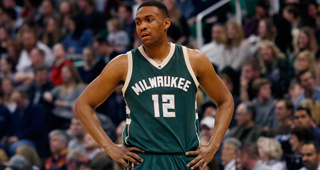The third season for highly-touted prospects is traditionally a red carpet affair. Most find themselves right in that sweet spot between their upcoming second NBA contract and the final days of a honeymoon.
But sometimes weird stuff happens, stocks drop, and well-known talents with impressive pedigrees still manage to catch us by surprise.
Jabari Parker may be the next example, despite the largest spotlight for his own team shining on a different 21-year-old. Destined for stardom as the second overall pick in a loaded draft class, the Milwaukee Bucks forward lost a majority of his rookie season to a torn ACL, and then spent year two steadily crawling back towards his lofty expectations, while competing for the biggest disappointment in the Eastern Conference. Expectations were tempered.
In that time, Giannis Antetokounmpo snatched all the attention and elevated himself as a $100 million revolution-starter who may be about to qualify for his first All-Star game. Parker isn’t necessarily in the shadows, but he’s also not the first player anyone thinks of whenever Milwaukee comes up in conversation.
But thanks to Khris Middleton’s potentially season-ending hamstring injury and the decision to replace Michael Carter-Williams with Tony Snell’s faint usage rate, Parker has an opportunity to bludgeon the league in 2017.
We’re all generally familiar with who Parker is—defense: bad—but with only 101 games to study, his ceiling remains a mystery. Sometimes he’s explosive and graceful. Other times he’ll force a long two or awkwardly submit a step-back jumper that shatters Milwaukee’s offensive rhythm.
But those negative sequences aren’t common. Parker made nearly half his shots with Milwaukee’s fifth highest usage rate on the team. His post-All-Star break numbers feel like a sign of great things to come: 18.9 points, 6.1 rebounds, 2.2 assists per game. He also shot 49.8 percent from the floor and went 9-of-28 behind the three-point line (versus 0-of-7 in nearly 1400 minutes before the break).
Even with those numbers, Parker can’t be called a stretch four because, well, he doesn’t stretch the defense. But since he struggles to guard wings, bumping him up a position and letting him attack slower, bigger defenders makes a ton of sense. (About 90 percent of his minutes were at power forward last year.)
Sometimes that’s a problem. But Parker has already shown the ability to thrive beside another ball-dominant persona, attempting the seventh most shots from cuts last season. Drop too far off him and Parker will dart into an open spot and make his man look silly.
Furthermore, context matters! The Bucks attempted fewer threes than any team in the league last season. Greg Monroe, Carter-Williams, Antetokounmpo, and just about everyone else on the roster couldn’t shoot.
Even though Middleton (a career 40 percent three-point shooter) will miss most of the season, Parker’s life should be easier with Matthew Dellavedova at point, Snell replacing Carter-Williams, and incoming Mirza Teletovic at the four.
That’s good news, considering Parker is low-key already one of the game’s top finishers. As a rookie, Parker shot 70.7 percent in the restricted area on 4.9 attempts per game. That same year, LeBron James shot 69.7 percent while averaging 1.7 more shots. Parker’s year was cut short after just 25 games, so the sample size is small, but he blasted his way into the league with an identifiable, highly useful ability that will never go out of style.
His percentages dipped a bit last season, in small part because Jared Dudley and Brandon Knight were no longer around to keep help defenders honest. But Parker’s restricted area acumen appears to be all the way back. (He’s shooting 70.3 percent this preseason.)
What type of career will he have? Maybe he’s Carmelo Anthony (without all the dribbling), an earth-shaking scorer who never becomes more than a minus defender despite respectable work on the boards? It’s possible if he becomes a threat from behind the three-point line (He’s shooting 40 percent beyond the arc on two attempts per game in the preseason—again, that’s a small sample size, but still.) Or maybe he’s a rich man’s Thaddeus Young, a complementary piece whose game wasn’t meant to thrive as a lead option.
This season isn’t a make-or-break year. But Parker’s growth is critical for a growing team that needs him to do more than roam off the ball, stand in the corner and attack in transition. With the ball in his hands, he’ll have to make plays for others, read help defenders and knock down a higher percentage of his outside shots.
If he does all those things and the Bucks compete for a playoff spot, don’t be surprised if Parker’s third year is the first where people realize he can be a perennial All-Star.



